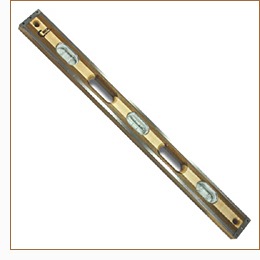Levels
 Lessons in Levels
Lessons in Levels
From ancient times, masons have searched the globe seeking just the right tool to enhance the artisanship of their trade. Often, a mason’s level is the tool that takes center stage.
In masonry circles, the old adage “close enough” just won’t suffice. As craftsmen, you live and breathe by the quality of your work. If a wall is not exactly level and plumb, the hands of gravity will turn your masterpiece into rubble. Calamities brought on by sub-quality work cost more than just time and money; reputations are on the line. Masons know that their signatures can be found within their work. A level can be seen as the “pen” used to assure this signature is bold and legible.
A mason’s level is a tool of legend. When you hold it in your hand, you feel the investment of quality and care. Its frame is durable and remains true under the harshest of treatment. Stainless-steel binding grips the edges of specially selected hardwoods, and the scent of raw linseed oil wafts into the air. Hand-set glass vials hold fast to the curve of the earth and tell the truth about plumb and level.
In the highest quality wooden mason’s level, you will find there are two sets of vials, one per side. This serves a three-fold purpose. It slows down the speed of the vial; it allows the operator to simply “grab and go” as the work flows; and it allows the mason to use both sides of the level.
If you look closely at the vials, you will notice they are curved. Vials that are straighter tend to “run” faster, making it harder to make fine adjustments to the work piece. Slowing down the run necessitates the curve, which demands that there be two vials per window.
The second reason for the dual vial design is the need for the “grab and go.” Masons don’t need to exhaust their time by constantly deciding which end of the level is up. With the dual vial design, all a mason has to do is grab it and go. There’s no need to consider which edge to use, which saves time and, therefore, money!
Finally, the dual vial design allows the craftsman to use both sides of the level. Less expensive levels only use the single vial design, which, in most cases, negates the use of both sides of the level. By going with the dual vial design, a mason is essentially doubling the value of his level, making his job easier.
When working with precision measuring tools, a true craftsman will not skimp on accuracy. Without accuracy, the wall is going to fall down eventually. When looking for the finest specimens in the world of levels, do your due diligence by checking out the claims of each manufacturer. The accuracy should be readily available.
Finally, in this day and age of fast food and cookie-cutter tools, a mason’s level stands unadorned and paramount in the trade that has helped to erect a nation. Hard-working masons have been relied upon for generations to bring that task to bear.